
Willows - Salix: the most beautiful varieties
Willows for every taste!
Contents
If you are looking for a vast and diverse botanical genus, why not take a closer look at the genus Salix: the Willows? Indeed, there are over 350 species spread across the northern hemisphere: trees, shrubs, large bushes, and small ground covers… Some are appreciated for their spectacular flowering (and nectariferous!), sometimes very colourful, while others are chosen for the beauty of their foliage. There are varieties with weeping, twisted, prostrate, bushy, and gangly habits… Some willows display bright red, burgundy, or even bluish stems. Generally very hardy, they adapt to almost all soils as long as they are relatively moist. In short, there are willows for every taste and every garden. Come and discover our little selection of our favourite willow varieties!
Growing a willow for its magnificent aments
All willow aments are beautiful. However, some species and cultivars reward us with spectacular or original ament colours (flowering of willows). This is the case for two particular willows.
Salix chaenomeloides ‘Mount Aso’ or Mount Aso Willow
Pink aments! This Japanese species is distinguished by its lovely fluffy pink-red aments, original and very decorative, which emerge as early as February and persist for several weeks. This small willow (no more than 3 m tall and 2.5 m wide) with reddish young shoots and beautiful autumn colours will be perfect as a specimen or in a shrubbery.
Salix gracilistyla var. melanostachys or ‘Wolf’s Claw’ Willow
Black aments! From February to April, large silky black aments, with red anthers, resembling wolf’s claws, appear on its reddish branches. Salix gracilistyla is a deciduous bush with a spreading habit and rapid growth. The shrub can quickly reach 2 m in height and 4 m in width. The red branches bear lanceolate grey-green leaves that evolve into a beautiful glossy green.
Cultivation: These two willows are native to Asia and appreciate the same care. They require sunlight and ordinary soil that remains moist throughout the year. Pruning after flowering will be beneficial for both shrubs to branch out and develop more colourful shoots.

Salix chaenomeloides Mount Aso (© Olivier Allard) and Salix gracilistyla var. melanostachys (© Virginie Douce)
Growing a willow for the colour of its stems
In the garden, we are familiar with branches in white, green, red, or even yellow among dogwoods or Rubus. They are so important during the dreary season. But how about a bush with blue branches? Yes, you read that right! The Salix acutifolia ‘Blue Streak’ is a lovely variety of willow from Siberia, whose red wood (“red? But we said blue!“) boasts large silver aments in spring. But beware, this red wood gradually takes on a very original white-blue to violet hue, which is particularly decorative, especially in winter.
Originating from Siberia, this Salix acutifolia is a large bush well-suited to the harshest climates. It has a bushy and spreading habit with long, flexible branches that are almost horizontal. Its growth is rapid, and it can reach a height of 4 metres in just a few years in all directions. Its deciduous foliage is formed of long, lanceolate dark green leaves with a blue-tinted underside, turning bright yellow in autumn.
Cultivation: this willow loves the sun and grows in any soil as long as it remains fresh while being relatively well-drained. It can be planted in hedges, as a specimen, or within a border, perhaps alongside other bushes with colourful branches.
Discover other Willow - Salix
View all →Available in 1 sizes
Available in 1 sizes
Available in 1 sizes
Available in 1 sizes
Available in 1 sizes
Available in 1 sizes
Available in 1 sizes
Available in 1 sizes
Available in 2 sizes
Available in 2 sizes
Growing a willow for the beauty of its foliage
Foliage in willows is not always green. It can be golden, as in the case of Salix sachalinensis ‘Golden Sunshine’, or even variegated with pink, green, and white, as seen in the now-famous shrimp willow.
Salix sachalinensis ‘Golden Sunshine’ or Golden Willow
The Golden Willow is a hardy deciduous bush that is both robust and decorative, thanks to its golden foliage that makes it particularly bright. It is a fast-growing shrub that can reach its adult size (between 2.5 and 4 metres in height) in just a few years. Its country-style silhouette with a bushy habit is brightened by a spring flowering in the form of aments, but especially by its lanceolate leaves of a beautiful and cheerful golden hue.
Cultivation: sun and cool soil. Very hardy, it appreciates a short pruning after flowering.
Salix integra ‘Hakuro Nishiki’ or Shrimp Willow
The Shrimp Willow has multicoloured and changing foliage, extremely decorative from spring to autumn. Its young shoots tinted with salmon pink (or shrimp) are variegated with pink and light green in spring, then with white and medium green in summer. It is a fast-growing shrub, with fine, flexible red branches, fairly compact, with a naturally rounded habit. Flowering occurs between March and April before the foliage appears.
Cultivation: as its foliage is variegated, the shrimp willow prefers a semi-shaded position. The soil should remain cool throughout the year. Its modest development (1.50 m in all directions) is suitable for small spaces: as a solitary specimen, at the centre of a perennial or shrub bed, or even in a large pot.

Salix sachalinensis ‘Golden Sunshine’ and Salix integra ‘Hakuro Nishiki’
Read also
7 weeping shrubsGrowing a willow for its unusual habit
Willows are not always “big balls” with flexible branches. Some exhibit unique habits: prostrate, upright, weeping, or twisted. It’s hard to list them all, but here are two beautiful examples: Salix (X) erythroflexuosa with its twisted habit and Salix caprea ‘Kilmarnok’ with its weeping form.
Salix (X) erythroflexuosa or Twisted Willow
Unlike the Salix matsudana, another twisted willow from which it is partly derived, Salix (X) erythroflexuosa additionally has a weeping habit. This willow develops long spirally twisted branches, initially upright and then trailing at the tips, covered with beautiful orange-red bark. The deciduous green leaves are also curled and twisted. Of modest stature (no more than 4 m tall), decorative throughout the year, this small tree fits well even in a small garden. This variety produces male catkins in greyish white in March, before the leaves appear.
Cultivation: deep, fresh to moist soil and full sun.
Salix caprea ‘Kilmarnok’ or Weeping Goat Willow
The Salix caprea ‘Kilmarnok’ is an old variety distinguished by its lovely weeping habit and modest stature (3 m tall and 2 m wide). It develops a crown of long trailing branches that reach the ground, forming a well-shaped parasol. From February to March, its bare branches are adorned with very decorative male catkins with silky silver hairs, turning yellow later. The dark green foliage consists of thick, leathery elliptical leaves. This willow is perfectly suited for small gardens, but also for container cultivation on the terrace.
Cultivation: very hardy. The Goat Willow adapts to ordinary soil in all our regions. It does not require consistently fresh or waterlogged soil throughout the year and can even withstand periods of moderate drought. Annual pruning after flowering is recommended to encourage the production of numerous flowering branches.
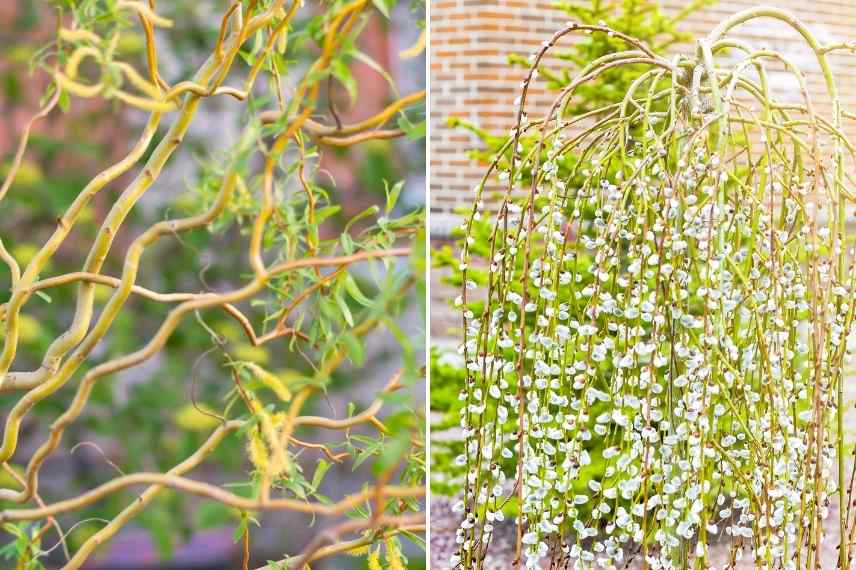
Salix erythroflexuosa and Salix caprea ‘Kilmarnok’
To grow a tiny willow
A dwarf willow? But really tiny? Yes, yes, it exists!
The Salix repens ‘Nitida’ is a variety of creeping willow with an even smaller growth habit than the typical species. Its lovely semi-weeping, nest-like habit and foliage covered in silvery down in spring, turning grey in summer make it special and perfect as a deciduous groundcover. Flowering occurs in April, producing small silky aments that turn yellow at ripeness.
This shrub can be used to create beautiful pots for the terrace, bright low hedges, or as a slightly unusual groundcover that will spread quickly thanks to its suckers. The cultivar ‘Nitida’ is more compact and bushy than the typical species: it will not exceed 60 cm in height with a spread of 75 cm.
Cultivation: full sun or partial shade in warm climates. A fairly deep soil, preferably neutral to acidic, rich in clay, cool to moist, even waterlogged. Perfectly cold-resistant.
Please note: The creeping willow or Salix repens is a species native to Eurasia. It can be found spontaneously in France: on dunes, in wet heathland, and in sphagnum peat moors.
Growing a willow in the South
Willow cultivation can sometimes be complicated in warmer areas with very dry summers, as is the case in much of France, particularly the southern half. However, a few willows can be attempted in relatively clayey and fairly deep soil. Salix caprea, Salix fargesii, Salix matsudana, and Salix gracilistyla tolerate calcareous soils and dry summers well, once established. But the one that will thrive the best is undoubtedly Salix exigua or Coyote Willow.
The Salix exigua or Coyote Willow is a deciduous botanical species native to the western part of North America. The bush has an upright but somewhat shaggy habit. The foliage consists of long, silky leaves that are bluish-grey and silver, giving it a light and luminous appearance. At maturity, this fast-growing willow will reach 4 m in height and 5 m in spread. The bush flowers late for a willow: between April and May. Male aments can measure up to 10 cm long, while female aments reach 8 cm in length.
Cultivation: Very hardy. In full sun and in all ordinary soils. The Coyote Willow does not require consistently moist or waterlogged soil throughout the year and even withstands occasional droughts quite well.
 Salix exigua or Coyote Willow
Salix exigua or Coyote Willow
Growing a willow in the mountains
Choosing plants can sometimes be challenging when gardening in the mountains: harsh climate, winds strong enough to knock over cattle, steep slopes, poor and shallow soils… In the case of willows, one can select a species particularly suited to the montane climate, as it is its natural habitat: Salix hastata or Hastate Willow.
The Salix hastata ‘Wehrhahnii’ is a lovely variety of Hastate Willow, selected for its abundant flowering. It is a charming little bushy willow (no more than 1 m in all directions), developing stems of a stunning wine-red colour. Between April and May, a multitude of large silver catkins, surrounded by gold at ripeness, appear alongside its green, fluffy foliage.
Cultivation: this montane willow thrives in full sun in well-drained soils, slightly acidic, and even in large rockeries that remain cool. It is extremely hardy.
Nota bene: The Hastate Willow is native to France in the Vosges, the Savoie Alps, the Dauphiné and Provence, as well as in the central Pyrenees.

Salix hastata
Bonus: two rare willows for collectors
Salix magnifica or Magnificent Willow
The magnificent willow (with an evocative name!) originates from Sichuan, a mountainous province in China. It is a small tree (no more than 7 m tall) that is quite rare in cultivation, distinguished in spring by its young shoots, buds, and petioles that turn crimson, igniting the long, ovate green leaves tinged with blue, nearly 20 cm long. Subsequently (March-April), feathery red aments appear and turn to apple green over the weeks.
Cultivation: in full sun, preferably in a sheltered position to protect it from severe frosts that could damage the young foliage, and in rich soil that is regularly amended, ideally kept fresh to very moist.
Salix fargesii or Farges Willow
The Salix fargesii or Farges willow is also a Chinese species. It is a rather bushy shrub that will not exceed 2 m in all directions. This willow is interesting for its foliage, but also for its ease of cultivation in almost any soil. Its large, dark green, glossy magnolia-like leaves are stunning and remarkable for a willow. But this bush has other assets: young red shoots from which large buds covered in silver bristles emerge, a smooth wood of beautiful coppery brown that can be admired in winter, and upright green aments in spring.
Cultivation: full sun or partial shade in ordinary soil. The Farges willow does not require consistently fresh or waterlogged soil throughout the year, and it will tolerate short periods of summer drought. Very resistant to cold, its young shoots can however, like this one, be damaged by late frosts.
- Subscribe!
- Contents
































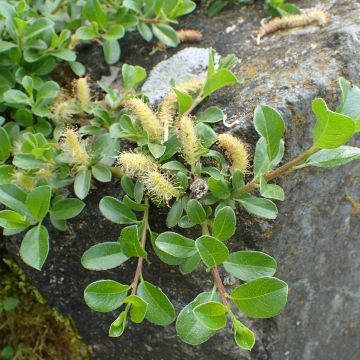
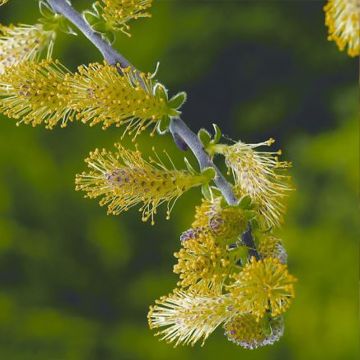
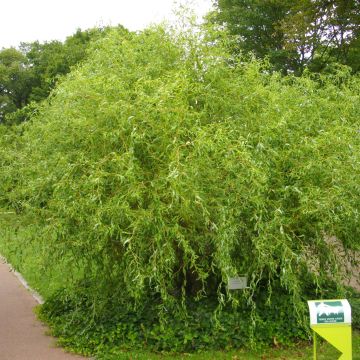


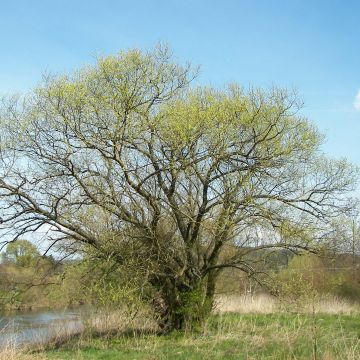

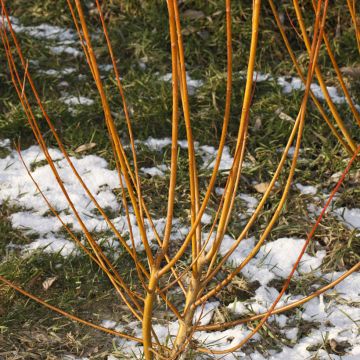

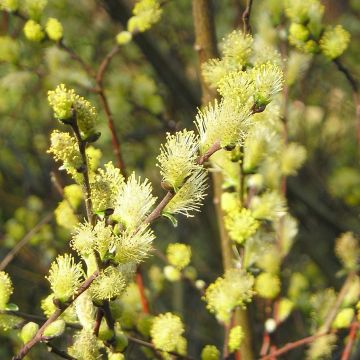
Comments